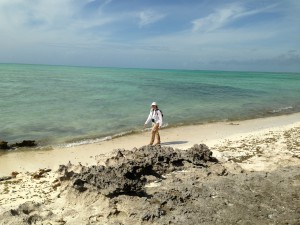Volunteer Guest Bloggers – Bahamas Piping Plover Project!
Connecting with Piping Plovers in a New Setting
This trip to the Bahamas we had three volunteers, piping plover experts, to help us survey stretches of Abaco that we have either not been able to survey or had limited opportunity to survey in the past. Our volunteers have a wide range of experience ranging from the U.S Fish and Wildlife Service, Pronatura Noreste A.C. Mexico, and a wildlife consulting company in Virginia. Below is their experiences from the week. Enjoy!
Annette Scherer, Retired U.S. Fish and Wildlife Service Endangered Species Biologist

When I retired a year ago after spending the better part of my career negotiating with stakeholders and regulatory agencies to balance piping plover protection with shoreline stabilization projects and human recreational use, I often joked that I was going to move somewhere with no plovers- no piping plovers, no snowy plovers, and not even mountain plovers. But when CWFNJ invited me along to survey for piping plovers in Abaco, Bahamas I jumped at the chance to learn more about piping plovers on their wintering grounds. My work with plovers in the northeast U.S. had focused on plovers on their breeding grounds where individual pairs of plovers fiercely defend their nesting territory. As a result, its unusual to see more than a pair of plovers and their brood of up to 4 chicks in a single spot. Here on the wintering grounds the bird’s habitat characteristics are very similar to that of their breeding areas – wide sandy coastal beaches, but their behavior is very different. The plovers congregate in small groups, roosting and feeding together. On my first survey day, I was thrilled to observe a group of eleven plovers roosting high on the beach. It was strange to see so many plovers calmly sitting together. Each bird was nestled down in a small depression that gave protection from the wind, reminding me of the shallow scrapes they make when building nests. It was great to finally see where the birds go when they leave the northeast and personally rewarding for me to now have observed the birds throughout their entire annual cycle.
Karen Terwilliger, Wildlife Biologist and Member of the Original Piping Plover Recovery Team, Terwilliger Consulting Inc.

I began my long journey of piping plovers in the early 1980’s when I observed and surveyed in Virginia. I was honored to be asked to join the Piping Plover Recovery Team in 1989. After many challenges and rewarding efforts on the breeding grounds for over 20+ years I was pleased to see the focus of recovery and protection encompass the migratory and wintering grounds for piping plovers. In 2011, I was asked to assist the U.S. Fish and Wildlife Service with the Comprehensive Conservation Strategy for Piping Plover in its Non-breeding Range. Today I see the implementation of these strategies, as they span from the U.S. to the Caribbean and Mexico. Through the efforts of CWFNJ and their partners, we continue collaborations with our colleagues from the Bahamas and also are able to include our partners from Mexico on this trip. We are hosted by our Bahamian business and community partners who share our appreciation of these birds and the need to conserve their habitats. It is deeply rewarding to see these efforts come full circle across countries. This trip has been incredibly productive and fun. I have witnessed local residents and businesses engaged in the project and become interested in conservation. I have seen school children and teachers delight in the integration of piping plover conservation because of the unique efforts of Todd Pover and Stephanie Egger. What a treat is has been to accompany them on this trip to reconnect with our northern breeders and see them here with their southern caretakers in their wintering grounds.
José Alfredo Alvarez Cerda, Biologist and Coordinator, Pronatura Noreste A.C. Mexico

The piping plover is one of the most endangered shorebird species of North America, so it is a priority to recover their populations and protect their breeding and winter habitat. I had a great opportunity to participate in the winter monitoring with CWFNJ in the Bahamas and learn about their field monitoring protocols and the work that is being done with the local people of Abaco through school and community educational and outreach programs. My inclusion in the monitoring has given me tools on methodologies that could be included in the survey program of Pronatura Noreste, with shorebirds in the Gulf of Mexico, and generate information that can be complementary to the work of different organizations in Mexico. Similarly, CWFNJ’s work with local schools and the sister school program is very important for the international link between Bahamas and the U.S for plovers. I hope we can continue to share experiences and information to help recover the piping plover in Mexico and the Caribbean!
Discover more from Conserve Wildlife Foundation of NJ
Subscribe to get the latest posts sent to your email.